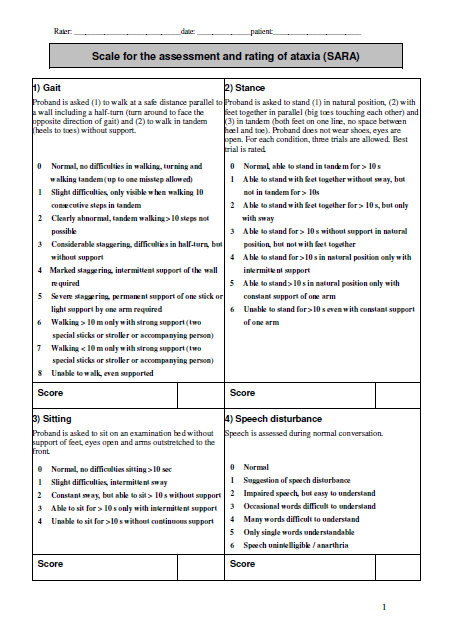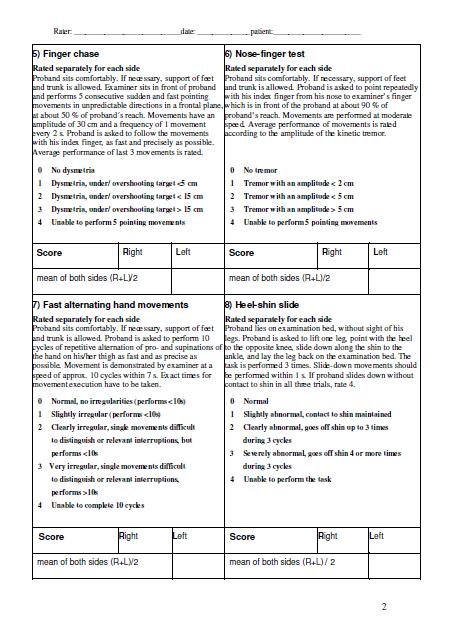Scale for the Assessment and Rating of Ataxia (SARA): Difference between revisions
Kate Sampson (talk | contribs) No edit summary |
Kate Sampson (talk | contribs) No edit summary |
||
| Line 18: | Line 18: | ||
== Method of Use == | == Method of Use == | ||
The SARA | The SARA is a tool for assessing ataxia. It has eight categories with accumilative score ranging from 0 (no ataxia) to 40 (most severe ataxia). When completing the outcome measure each category is assessed and scored accordingly. Scores for the eight items range as follows: | ||
1) Gait (0-8 points), | |||
2) Stance (0-6 points), | |||
3) Sitting (0-4 points) | |||
4) Speech disturbance (0-6 points) | |||
5) Finger chase (0-4 points) | |||
6) Nose-finger test (0-4 points) | |||
7) Fast alternating hand movement (0-4 points) | |||
8) Heel-shin slide (0-4 points) | |||
Once each of the 8 categories have been assessed, the total is calculated to determine the severity of ataxia. | |||
For motor activities of the four extremities (items 5-8), assessments are performed bilaterally, and the mean values are used to obtain the total score. <br> | |||
<br> | <br> | ||
| Line 25: | Line 45: | ||
[[Image:SARA Pg. 2..png|center]] | [[Image:SARA Pg. 2..png|center]] | ||
<ref name="Ataxia study group">Ataxia Study Group. Scale for the Assessment and Rating of Ataxia. http://www.ataxia-study-group.net/html/about/ataxiascales/sara/SARA.pdf (accessed 23 Feb 2016)</ref> | |||
== Evidence == | == Evidence == | ||
Revision as of 22:42, 23 February 2016
Original Editor - Ajay Upadhyay
Top Contributors -
Objective
[edit | edit source]
SARA is a clinical scale developed by Schmitz-Hübsch et al which assesses a range of diffierent impairments in cerebellar ataxia. The scale is made up of 8 items related to gait, stance, sitting, speech, finger-chase test, nose-finger test, fast alternating movements and heel-shin test.[1] Schmitz-Hübsch et al developed the Scale for the Assessment and Rating of Ataxia (SARA) as an alternative to The International Cooperative Ataxia Rating Scale (ICARS). The daily use of ICARS scale in ataxic patients is difficult due to its many assessment items.[2] This new assessment tool has fewer assessment items than the ICARS and therefore has the advantage of easier daily assessment of ataxia. [3]
Intended Population
[edit | edit source]
Currently the following types of Ataxia have been investigated:
- Spinocerebellar Ataxia[3][4][5]
- Ataxic Stroke [6]
Method of Use[edit | edit source]
The SARA is a tool for assessing ataxia. It has eight categories with accumilative score ranging from 0 (no ataxia) to 40 (most severe ataxia). When completing the outcome measure each category is assessed and scored accordingly. Scores for the eight items range as follows:
1) Gait (0-8 points),
2) Stance (0-6 points),
3) Sitting (0-4 points)
4) Speech disturbance (0-6 points)
5) Finger chase (0-4 points)
6) Nose-finger test (0-4 points)
7) Fast alternating hand movement (0-4 points)
8) Heel-shin slide (0-4 points)
Once each of the 8 categories have been assessed, the total is calculated to determine the severity of ataxia.
For motor activities of the four extremities (items 5-8), assessments are performed bilaterally, and the mean values are used to obtain the total score.
Evidence[edit | edit source]
High inter-rater reliability (ICCs5 0.90–0.96)
High test–re-test reliability (ICCs5 0.90–0.96)
High internal consistency (Cronbach’s a50.94)
Good internal structural validity
Links[edit | edit source]
Recent Related Research (from Pubmed)[edit | edit source]
Failed to load RSS feed from http://www.ncbi.nlm.nih.gov/entrez/eutils/erss.cgi?rss_guid=1JiS13ehHQEsQrBXatRfBPZbFPCGb6TWfKUmIQOwgpkq5zwwhf|charset=UTF-8|short|max=10: Error parsing XML for RSS
References[edit | edit source]
References will automatically be added here, see adding references tutorial.
- ↑ Weyer A, Abele M, Schmitz-Hubsch T, Schoch B, Frings M, Timmann D. Reliability And validity of the scale for the assessment and rating of ataxia: a study in 64 Ataxia patients. Movement Disorders 2007;22:1633–7
- ↑ Trouillas P, Takayanagi T, Hallett M, Currier RD, Subramony SH, Wessel K, Bryer A, Diener HC, Massaquoi S, Gomez CM, et al. The Ataxia Neuropharmacology Committee of the World Federation of Neurology. International Cooperative Ataxia Rating Scale for pharmacological assessment of the cerebellar syndrome. J Neurol Sci. 1997;145:205–211.
- ↑ 3.0 3.1 Schmitz-Hübsch T, du Montcel ST, Baliko L, Berciano J, Boesch S, Depondt C, Giunti P, Globas C, Infante J, Kang JS, et al. Scale for the assessment and rating of ataxia: development of a new clinical scale. Neurology. 2006;66:1717–1720.
- ↑ Schmitz-Hübsch T, Fimmers R, Rakowicz M, Rola R, Zdzienicka E, Fancellu R, Mariotti C, Linnemann C, Schöls L, Timmann D, Filla A. Responsiveness of different rating instruments in spinocerebellar ataxia patients. Neurology. 2010 23;74(8):678-84.
- ↑ Ataxia UK. Management of the Ataxias: towards best clinical practice. November 2009 http://www.ataxia.org.uk/Pages/News/Category/clinical-guidlines (accessed 23 Feb 2016)
- ↑ Kim BR, Lim JH, Lee SA, Park S, Koh SE, Lee IS, Jung H, Lee J.Usefulness Of the Scale For the Assessment And Rating Of Ataxia (SARA) In ataxic stroke patients.Ann Rehabil Med 2011;35:772–80
- ↑ Bürk K, Mälzig U, Wolf S, Heck S, Dimitriadis K, Schmitz‐Hübsch T, Hering S, Lindig TM, Haug V, Timmann D, Degen I. Comparison of three clinical rating scales in Friedreich ataxia (FRDA). Movement Disorders 2009. 15;24(12):1779-84.
- ↑ Saute JA, Donis KC, Serrano-Munuera C, Genis D, Ramirez LT, Mazzetti P, Pérez LV, Latorre P, Sequeiros J, Matilla-Dueñas A, Jardim LB. Ataxia rating scales—psychometric profiles, natural history and their application in clinical trials. The Cerebellum. 2012 Jun 1;11(2):488-504.
- ↑ Ataxia Study Group. Scale for the Assessment and Rating of Ataxia. http://www.ataxia-study-group.net/html/about/ataxiascales/sara/SARA.pdf (accessed 23 Feb 2016)








